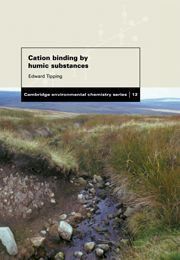Book contents
- Frontmatter
- Contents
- Preface
- 1 Introduction
- 2 Humic substances – a brief review
- 3 Environmental solution and surface chemistry
- 4 Proton dissociation from weak acids
- 5 Metal–ligand interactions
- 6 Methods for measuring cation binding by humic substances
- 7 Quantitative results with isolated humic substances
- 8 Cation binding sites in humic substances
- 9 Parameterised models of cation–humic interactions
- 10 Applications of comprehensive parameterised models
- 11 Predictive modelling
- 12 Cation–humic binding and other physico-chemical processes
- 13 Cation binding by humic substances in natural waters
- 14 Cation binding by humic substances in soils and sediments
- 15 Research needs
- References
- Index
11 - Predictive modelling
Published online by Cambridge University Press: 18 August 2009
- Frontmatter
- Contents
- Preface
- 1 Introduction
- 2 Humic substances – a brief review
- 3 Environmental solution and surface chemistry
- 4 Proton dissociation from weak acids
- 5 Metal–ligand interactions
- 6 Methods for measuring cation binding by humic substances
- 7 Quantitative results with isolated humic substances
- 8 Cation binding sites in humic substances
- 9 Parameterised models of cation–humic interactions
- 10 Applications of comprehensive parameterised models
- 11 Predictive modelling
- 12 Cation–humic binding and other physico-chemical processes
- 13 Cation binding by humic substances in natural waters
- 14 Cation binding by humic substances in soils and sediments
- 15 Research needs
- References
- Index
Summary
The comprehensive models described in Chapter 9, and evaluated in Chapter 10, depend upon fitting data to equations. In Model VI, assumptions are made about molecular size and shape in the electrostatic sub-model, and in the calculation of proximity factors (defining multidentate sites). These aspects of Model VI can therefore be regarded as predictive, i.e. not dependent upon data fitting. The purpose of this chapter is to discuss how predictive modelling can be taken further, the ultimate aim being to describe cation binding from knowledge about humic molecular properties, structures and sizes, without the need to extract parameters from binding data.
Electrostatic interactions
As has already been discussed in Section 9.5, electrostatic interactions can be simulated given information or assumptions about molecular size, shape, solvent permeability and net charge. Some work has been done to explore the influence of molecular size heterogeneity, which may influence the overall binding characteristics of a humic sample. Thus, a physically more realistic model is obtained by the strategy of Bartschat et al. (1992), i.e. postulating the humic matter to consist of molecules with a range of electrostatic characteristics, dependent upon molecular size. Implementation requires knowledge or assumptions about the size distribution of the sample.
As well as size, Coulombic effects depend upon the conformations of the humic molecules, the extent to which the structures are penetrated by water, and the degree to which conformations change as a function of molecular charge and solution conditions.
Information
- Type
- Chapter
- Information
- Cation Binding by Humic Substances , pp. 253 - 261Publisher: Cambridge University PressPrint publication year: 2002
Accessibility standard: Unknown
Why this information is here
This section outlines the accessibility features of this content - including support for screen readers, full keyboard navigation and high-contrast display options. This may not be relevant for you.Accessibility Information
- 1
- Cited by
